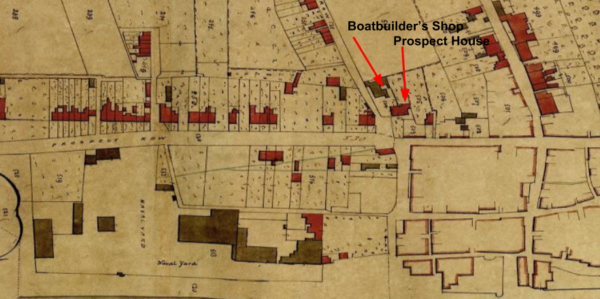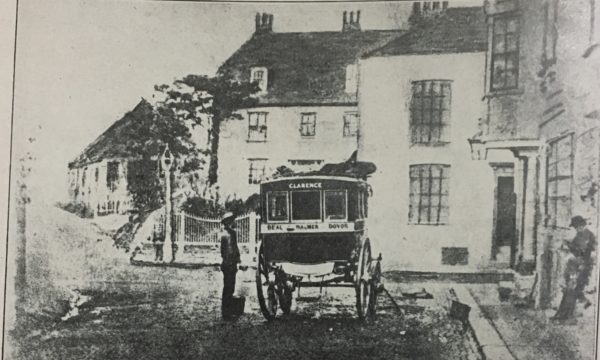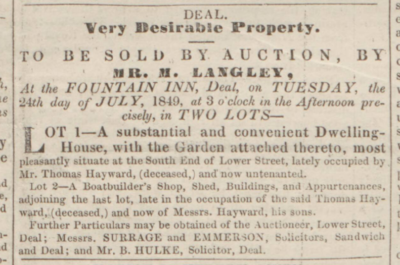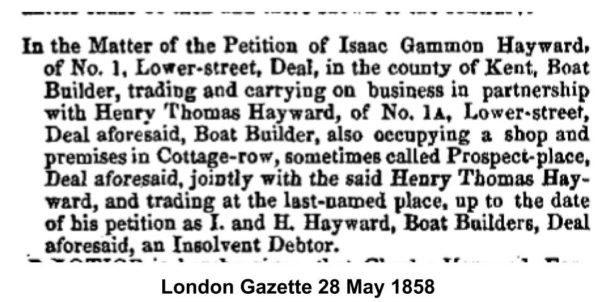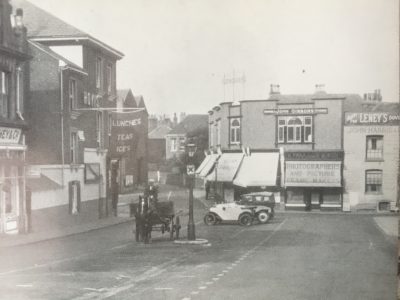Prospect House
Prospect House was built on the corner of what was then Lower Street and Cottage Row, facing straight up South Street to the beach. The house, with an adjoining cottage, can still be found today though the street names have changed from Lower to High Street and from Cottage Row to Wellington Road and another premises, now Kings Cafe, stands in what was once the front garden.
Prospect House itself, has long been associated with boat-builder Thomas Hayward. But was he the houses’ first occupant? So far we haven’t been able to locate any surviving documents to tell us this with any real certainty, and those that we have found have left us with more questions than answers.
What do we know?
Behind the house were the boat-builders, shop and yard and in front of the house was a garden surrounded by a picket fence.
Taken from Reminiscences of Old Deal by E C Pain.
Neither the house nor boat-shop is shown on the two maps that we found dating 1806 and 1807 but they appear to show the front garden as this is marked on them as a piece of tithe free land.
ADD IN MAP
The Parish Rates Assessment for 1804 and 1805 both say that Isaac Gammon was paying rates for “The Shop & Wine Vaults & Cottage” on Lower Street.
We know from baptism records that Thomas’ thirteenth child, Henry, was born there in 1821. Thomas also appears in the parish cess for that year paying rates on a property on Lower Street that is described as a “House with a Storehouse a Garden in Prospect Row with Wine Vault House and Boat Shop”.
Until then he had been living in a property leased from the Archbishop of Canterbury on Prospect Row, also known as Prospect Place and now Victoria Road.
So, it appears safe to say that Prospect House was built before 1821, but by who? The answer is we simply don’t know.
Thomas Hayward’s first wife was Keziah Gammon, the niece of Isaac Gammon, a boat-builder, wine-merchant and twice Mayor of Deal. He also once lived on Prospect Row, leasing from the Archbishop, before moving to Beach Street.
In Isaac’s will, that was proved in 1822, he left the bulk of his estate to his nephew, Keziah’s brother, William Gammon, a Ship Broker living in Ratcliffe, Middlesex. The will says that:
“…I bequeath unto my nephew William Gammon….all my freehold messuage, tenement or dwelling house now in my own occupation (this must be the Beach Street property) and also all that my freehold Boatbuilders shop now in the occupation of Thomas Hayward and also all the Buildings, Yards, Gardens, Land, Ground and appurtenances to the same messuage tenement or dwelling house, Boatbuilders shop and premises respectively belonging or in anywise appertaining together with a small piece or parcel of leasehold land (details of the purchase is given here) on which is now laid into and forms part of, the frontcourt of my said messuage, tenement or dwelling house, all which said premises are adjoining together and are situate, lying and being at the South end of the town of Deal ...”
This does seem to describe the image below showing Prospect House and its front garden with the Boatbuilders shop behind.
Which, if so, raises the question of how Thomas ended up the owner of Prospect House and the Boat-building yard?
We can only assume then that, if the property in Isaacs’ will is Prospect House, then Thomas at some point must have purchased it and also the Boat-yard from William Gammon who continued to live in Ratcliffe until his death in 1845.
No matter how Thomas gained Prospect House he and family continued to live and work there until he died, in 1848 aged 80. He had outlived both his wives, Keziah and Dorothy who in total had given him fourteen children. All his surviving children are mentioned in his will in which he requests that his house, yards, gardens workshop and sawpit are to be sold by public auction or private contract. As per his wishes, an advert was placed in the Dover Telegraph and Cinque Ports General Advertiser of Saturday 21 July 1849.
In his will, Thomas confusingly says his house is in Prospect ‘Place,’ now Victoria Road.
To add to the confusion, at the time that Thomas was writing his will, this road was also known as Prospect ‘Row’. This may be cleared up by the later bankruptcy notices for Thomas’ sons, Isaac Gammon and Henry Thomas, where it appears to say that Cottage Row, where the shop and yard are situated, was “…sometimes known as Prospect Place…”
And Today
The front garden of this lovely building was built over in the 1860/70s forever hiding Prospect House from view as you can see from this early 1900s image taken from South Street.
Sources:
Newspaper image © The British Library Board. All rights reserved.
With thanks to The British Newspaper Archive (www.britishnewspaperarchive.co.uk)
Taken from Reminiscences of Old Deal by E C Pain.
Deal Tithe Map- DCb/T/O/D/2A,2B
Isaac Gammon’s Will -The National Archives – PROB 11/1660/220
